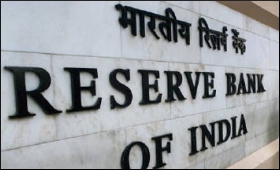In a surprise move, the Reserve Bank of India (RBI) on Thursday took a 'temporary pause' in reducing key lending rates to keep the retail inflation in check.
Accordingly, the RBI's monetary policy committee (MPC) in its fifth review of the current fiscal kept the repo, or short term lending rate for commercial banks at 5.15 per cent.
Consequently, the reverse repo rate was maintained at 4.90 per cent, and the marginal standing facility (MSF) rate and the bank rate remained at 5.40 per cent.
The Reserve Bank had reduced key lending rates during the last five policy reviews to reverse the current consumption slowdown that has plagued the country's economy, thus surprising India Inc and many economists.
However, the Reserve Bank's Monetary Policy Committee continued its accommodative stance.
"The MPC also decided to continue with the accommodative stance as long as it is necessary to revive growth, while ensuring that inflation remains within the target," the Fifth Bi-monthly Monetary Policy Statement, 2019-20 said.
Last month, macro-economic data showed that a substantial rise in food prices had lifted India's October retail inflation to 4.62 per cent from 3.99 per cent in September.
Furthermore, RBI MPC expects inflation to rise in the near-term, "but it is likely to moderate below target by Q2 of 2020-21".
On the other hand, it reduced the country's FY20 GDP growth forecast from 6.1 per cent in the October policy to 5 per cent.
"The MPC recognises that there is monetary policy space for future action. However, given the evolving growth-inflation dynamics, the MPC felt it appropriate to take a pause at this juncture," the policy statement said.
"Accordingly, the MPC decided to keep the policy repo rate unchanged and continue with the accommodative stance as long as it is necessary to revive growth, while ensuring that inflation remains within the target."
RBI Governor Shaktikanta Das defended the decision by recalling the "primary objective" of the central bank, which is inflation targeting and price control.
Speaking to the media after the announcement, Das said that the headline inflation is currently high, largely due to high food inflation. He further said that food inflation will remain "very high" during January-March, which prompted the RBI to hit the pause button on rate cuts.
Not just India Inc but even the country's stock markets were taken in by surprise and plunged the S&P BSE Sensex into the red.
The Sensex traded at 40,815.15, lower by 35.14 points or 0.09 per cent from the previous close of 40,850.29.
Similarly, the NSE Nifty50 traded at 12,031.95, lower by 11.25 points or 0.09 per cent from its previous close.
Commenting on the monetary policy, Ficci President Sandip Somany said: "The RBI has left the repo rate unchanged in today's announcement. This is contrary to what Ficci was expecting given the weakening growth scenario in the economy."
"We note with concern that the transmission of the earlier policy rate cuts has not happened adequately, and are disappointed with the decision to not cut the repo rate as there is need for continued action on the policy rate front."
Another business body Assocham's President B.K. Goenka said: ''Temporary pause by the RBI to the policy interest rate reduction cycle while keeping its stance accommodative is understandable as long as it keeps nudging the banks to significantly pass the benefits of earlier rate combined REPO rate cuts of 135 basis points since February this year''.
On its part, Care Ratings said that it expects a rate cut of 25 bps in the next monetary policy (Feb'19) provided there is a moderation in retail inflation in the preceding 2 months.
"We also believe inflation to remain elevated during November-December and could ease thereafter. By March, 2020 it would be around 4-4.5 per cent, which is within the flexible inflation target band of 4 per cent (+/- 2 per cent)," Care Ratings said.
According to Edelweiss Securities' Economist Madhavi Arora: "We do realise the policy paradigm has to move beyond rate cuts and should focus more on addressing the problem of credit and business confidence and overall financial stability to break the selective liquidity trap for optimisation of the rate transmission."
Published On : 06-12-2019
Source : SME Times

